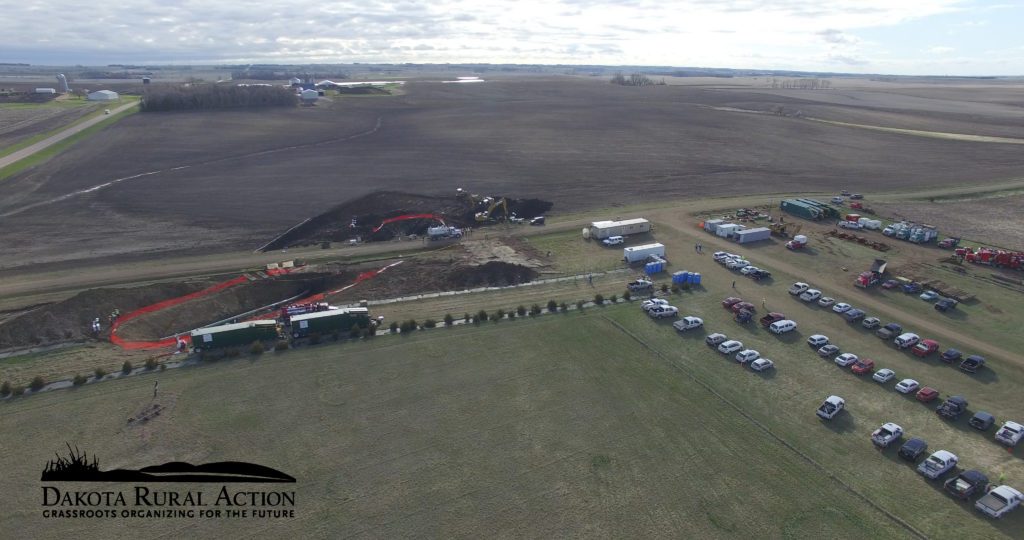One week ago, South Dakotans woke up to a surprise news report from WNAX: Keystone I, TransCanada’s tar sands crude pipeline on the eastern side of the state, had spilled over the weekend. Over the course of the next few days, more details came out about what this really meant.
We are a long way off from fully understanding what happened and why, but a week after the spill was first reported, here is what we know:
WHAT WE KNOW:
TransCanada didn’t know their pipeline was leaking until it was reported by local landowner. Sensors do not pick up a spill until pressure drops at least 1.5%; for a pipeline carrying nearly half a million gallons of tar sands crude every day, a spill could reach disaster levels before being detected.
At the request of TransCanada, the FAA enacted a temporary “no-fly zone” over the spill shortly after it was reported. There is still no information about why the order was requested or why the request was granted. Dakota Rural Action has issued a FOIA to the FAA to answer these questions.
It took the company nearly a week to pinpoint where the leak came from itself. Despite having said publicly that they found the source of the spill, they have not publicly released information that would show whether or not the spill was a result of problems that could be found elsewhere on the pipeline itself.
In order to find the leak, TransCanada had to dig up nearly 250 feet of pipeline, raising questions about how the company will reclaim the land they have once again disturbed. The company does not have a good track record for land reclamation, as seen in multiple lawsuits and testimony by landowners at the Keystone XL hearing last July.
While initial reports were that the spill was smaller than 5 barrels, late last week TransCanada reported the spill was nearly 400 barrels – almost 17,000 gallons of crude.
Despite there being no evidence that another spill is not likely, the pipeline began operating at reduced pressure on Sunday.
And, we still don’t know what all was in the “chemical cocktail” that spilled out of Keystone I.

TIMELINE SUMMARY:
Saturday, April 2: South Dakota landowner notices a sheen of oil near where Keystone I is buried. Several hours later, TransCanada shuts down Keystone I pipeline operations. No public alert is issued.
Saturday-Sunday, April 3: Company representatives and government regulators start reporting to the site of the spill for initial assessments. Still no public alert is issued.
Monday, April 4: Finally, public notification of a “small leak” is given. Dakota Rural Action members mobilize to get out to the site, take pictures, and start assessing the leak damage. Notice of a no-fly zone is given.
Tuesday, April 5: By this time, over 100 people are on site to work on the spill, and crews start excavating large segments of pipeline in search of the actual leak. No-fly zone order is removed.
Wednesday, April 6: Dakota Rural Action files FOIA on FAA requesting more information about the no-fly zone. Crews still unable to pinpoint leak.
Thursday, April 7: Trucks start hauling away contaminated soil and clay from the spill site. Spill estimate is drastically altered to 400 barrels of crude, nearly 90 times larger than initially reported.
Friday, April 8: TransCanada finally finds the source of the leak.
Sunday, April 10: Keystone I resumes operations as lower pressure under the supervision of the Pipeline and Hazardous Materials Safety Administration.
WHAT HAPPENS NOW?
There is still a lot we don’t know about what really happened, how large the spill really is, and how long we’ll have to wait for the land to be reclaimed. We will continue to hold our state officials accountable for ensuring cleanup is done properly. We will keep fighting these pipelines – both Keystone XL and Dakota Access. And we’ll keep organizing locally to build strong leaders in South Dakota who can speak up, speak out, and built the future we want for our state.
What You Can Do
- Support Dakota Rural Action’s Keystone XL appeal: we have appealed the Public Utilities Commission’s decision to approve Keystone XL. Their decision flies in the face of South Dakotans who have fought for seven years to prove this pipeline would not be safe. You can support our appeal by clicking here to donate.
- Stop Dakota Access: Support the Standing Rock Spirit Camp built to stop the Dakota Access pipeline (you can read more about it here). You can also support those pressuring the Army Corps of Engineers to do a full environmental impact statement.
